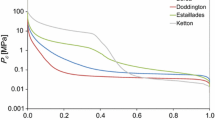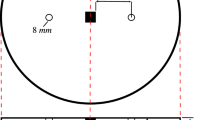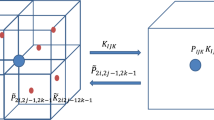Abstract
Digital material characterisation from microstructural geometry is an emerging field in computer simulation. For permeability characterisation, a variety of studies exist where the lattice Boltzmann method (LBM) has been used in conjunction with computed tomography (CT) imaging to simulate fluid flow through microscopic rock pores. While these previous works show that the technique is applicable, the use of binary image segmentation and the bounceback boundary condition results in a loss of grain surface definition when the modelled geometry is compared to the original CT image. We apply the immersed moving boundary (IMB) condition of Noble and Torczynski as a partial bounceback boundary condition which may be used to better represent the geometric definition provided by a CT image. The IMB condition is validated against published work on idealised porous geometries in both 2D and 3D. Following this, greyscale image segmentation is applied to a CT image of Diemelstadt sandstone. By varying the mapping of CT voxel densities to lattice sites, it is shown that binary image segmentation may underestimate the true permeability of the sample. A CUDA-C-based code, LBM-C, was developed specifically for this work and leverages GPU hardware in order to carry out computations.


















Similar content being viewed by others
References
Boek ES, Venturoli M (2010) Lattice-Boltzmann studies of fluid flow in porous media with realistic rock geometries. Comput Math Appl 59(7):2305–2314
Ahrenholz B, Tölke J, Krafczyk M (2006) Lattice-Boltzmann simulations in reconstructed parametrized porous media. Int J Comput Fluid Dyn 20(6):369–377
Lenoir N, Andrade JE, Sun WC, Rudnicki JW (2010) In situ permeability measurements inside compaction bands using X-ray CT and lattice Boltzmann calculations. In: Proceedings of GeoX, 2010
Grader A, Mu Y, Toelke J, Baldwin C (2010) Estimation of relative permeability using the Lattice Boltzmann method for fluid flows, Thamama Formation, Abu Dhabi. In: Proceedings of the Abu Dhabi international petroleum exhibition and conferences, Abu Dhabi, 2010
Ginzburg I, D’Humières D (2003) Multi-reflection boundary conditions for lattice Boltzmann models. Phys Rev E 68(6):066614
Noble DR, Torczynski JR (1998) A lattice-Boltzmann method for partially saturated computational cells. Int J Mod Phys C 09(08):1189–1201
Aidun CK, Clausen JR (2010) Lattice-Boltzmann method for complex flows. Annu Rev Fluid Mech 42(1):439–472
Nabovati A, Llewellin EW, Sousa ACM (2009) A general model for the permeability of fibrous porous media based on fluid flow simulations using the lattice Boltzmann method. Composites A 40(6–7):860–869
Guo Z, Zhao T (2002) Lattice Boltzmann model for incompressible flows through porous media. Phys Rev E 66(3):036304
Lerner RG, Trigg GL (1990) Encyclopedia of physics, 2nd edn. Wiley, New York
Currie IG (2003) Fundamental mechanics of fluids, 3rd edn. Marcel Dekker, Inc., New York
Chapman S, Cowling TG (1991) The mathematical theory of non-uniform gases. An account of the kinetic theory of viscosity, thermal conduction and diffusion in gases. Cambridge University Press, Cambridge
Chen S, Doolen GD (1998) Lattice Boltzmann method for fluid flows. Annu Rev Fluid Mech 30(1):329–364
Wolf-Gladrow DA (2015) Lattice-gas cellular automata and lattice Boltzmann models—an introduction. Springer, Heidelberg
Rothman DH (1988) Cellular-automaton fluids: a model for flow in porous media. Geophysics 53(4):509
McNamara GR, Zanetti G (1988) Use of the Boltzmann equation to simulate lattice-gas automata. Phys Rev Lett 61(20):2332–2335
Higuera FJ, Jiménez J (2007) Boltzmann approach to lattice gas simulations. Europhys Lett 9(7):663–668
Bhatnagar PL, Gross EP, Krook M (1954) A model for collision processes in gases. I. Small amplitude processes in charged and neutral one-component systems. Phys Rev 94:511–525
Qian YH, D’Humières D, Lallemand P (1992) Lattice BGK models for Navier–Stokes equation. Europhys Lett 17:479
Chen H, Chen S, Matthaeus WH (1992) Recovery of the Navier–Stokes equations using a lattice-gas Boltzmann method. Phys Rev A 45(8):R5339–R5342
Feng YT, Han K, Owen DRJ (2007) Coupled lattice Boltzmann method and discrete element modelling of particle transport in turbulent fluid flows: computational issues. Int J Numer Methods Eng 72(9):1111–1134
D’Humieres D (1992) Rarefied gas dynamics: theory and simulation. In: Progress in astronautics and aeronautics, vol 159. AIAA (Washington), pp 450–458
Pan C, Luo L-S, Miller CT (2006) An evaluation of lattice Boltzmann schemes for porous medium flow simulation. Comput Fluids 35(8–9):898–909
D’Humières D, Ginzburg I (2009) Viscosity independent numerical errors for Lattice Boltzmann models: from recurrence equations to magic collision numbers. Comput Math Appl 58(5):823–840
He X, Zou Q, Luo L-S, Dembo M (1997) Analytic solutions of simple flows and analysis of nonslip boundary conditions for the lattice Boltzmann BGK model. J Stat Phys 87(1):115–136
Leonardi CR (2009) Development of a computational framework coupling the non-Newtonian lattice Boltzmann method and the discrete element method with application to block caving. PhD Thesis, Swansea University
Holdych DJ (2003) Lattice Boltzmann methods for diffuse and mobile interfaces. PhD Thesis, University of Illinois at Urbana-Champaign
Strack EO, Cook BK (2007) Three-dimensional immersed boundary conditions for moving solids in the lattice-Boltzmann method. Int J Numer Methods Fluids 55(2):103–125
Ye Y, Chi P, Wang Y (2014) An efficient implementation of entropic lattice Boltzmann method in a hybrid CPU–GPU computing environment. In: Xiao Z, Wang Y, Du J, Li K, Li K (eds) Parallel computational fluid dynamics. Communications in computer and information science, vol 405. Springer, Berlin, pp 136–148
Bailey P, Myre J, Walsh SDC, Lilja DJ, Saar MO (2009) Accelerating lattice Boltzmann fluid flow simulations using graphics processors. In: International conference on parallel processing, 2009. ICPP ’09, pp 550–557
Massaioli F, Amati G (2002) Achieving high performance in a LBM code using OpenMP. In: The fourth European workshop on OpenMP, Roma, Italy
Hill RK, Koch DL, Ladd AJC (2001) The first effects of fluid inertia on flows in ordered and random arrays of spheres. Journal of Fluid Mechanics 448:213–241
Hill RK, Koch DL, Ladd AJC (2001) Moderate-Reynolds-number flows in ordered and random arrays of spheres. Journal of Fluid Mechanics 448:243–278
Ladd AJC (1994) Numerical simulations of particulate suspensions via a discretized Boltzmann equation. Part 2. Numerical results. Journal of Fluid Mechanics 271:285–309
Van Der Hoef MA, Beetstra R, Kuipers JAM (2005) Lattice-Boltzmann simulations of low-Reynolds-number flow past mono- and bidisperse arrays of spheres. Journal of Fluid Mechanics 528:233–254
Leonardi CR, Jones BD, Holmes DW, Williams JR (2013) Simulation of complex particle suspensions using coupled lattice Boltzmann-discreet element methods. In: 6th International conference on discrete element methods (DEM6), 2013
Zick AA, Homsy GM (1982) Stokes flow through periodic arrays of spheres. Journal of fluid mechanics 115:13–26
Kozeny J (1927) Über kapillare Leitung des Wassers im Boden. Akad. Wiss. Wien 136:271–306
Carman PC (1937) Fluid flow through granular beds. Chemical Engineering Research & Design 75:S32–S48
Ergun S, Orning AA (1949) Fluid Flow through Randomly Packed Columns and Fluidized Beds. Industrial & Engineering Chemistry 41(6):1179–1184
Lee SL, Yang JH (1997) Modeling of Darcy-Forchheimer drag for fluid flow across a bank of circular cylinders. International Journal of Heat and Mass Transfer 40(13):3149–3155
Liu S, Afacan A, Masliyah J (1994) Steady Incompressible Laminar Flow in Porous Media. Chemical Engineering Science 49(21):3565–3586
Jeong Namgyun, Choi Do Hyung, Lin Ching-Long (2006) Prediction of Darcy-Forchheimer drag for micro-porous structures of complex geometry using the lattice Boltzmann method. Journal of Micromechanics and Microengineering 16(10):2240–2250
Louis Laurent, Wong Teng-fong, Baud Patrick, Tembe Sheryl (2006) Imaging strain localization by X-ray computed tomography: discrete compaction bands in Diemelstadt sandstone. Journal of Structural Geology 28(5):762–775
Guodong J, Patzek TW, Silin D (2004) Direct prediction of the absolute permeability of unconsolidated and consolidated reservoir rock. In: SPE annual technical conference and exhibition, Houston, Texas, 2004
Okabe H (2004) Pore-scale modelling of carbonates. PhD Thesis, Imperial College, London
Boas FE, Fleischmann D (2012) CT artifacts: causes and reduction techniques. Future Medicine 4(2):229–240
Maruyama K, Koichi O, Miyazima S (1992) Critical exponents of continuum percolation. Physica A 191:313–315
Hunt A, Ewing R, Ghanbarian B (2014) Percolation theory for flow in porous media, 1st edn. Springer, Heidelberg
Sukop MC, Huang H, Alvarez PF, Variano EA (2013) Evaluation of permeability and non-Darcy flow in vuggy macroporous limestone aquifer samples with lattice Boltzmann methods. Water Resources Research 49(1):216–230
Yang Zeng, Peng Xiao-Feng, Lee Duu-Jong, Su Ay (2007) Reynolds number-dependent permeability of wastewater sludge flocs. Journal of the Chinese Institute of Chemical Engineers 38(2):135–141
Author information
Authors and Affiliations
Corresponding author
Rights and permissions
About this article
Cite this article
Jones, B.D., Feng, Y.T. Effect of image scaling and segmentation in digital rock characterisation. Comp. Part. Mech. 3, 201–213 (2016). https://doi.org/10.1007/s40571-015-0077-0
Received:
Revised:
Accepted:
Published:
Issue Date:
DOI: https://doi.org/10.1007/s40571-015-0077-0




